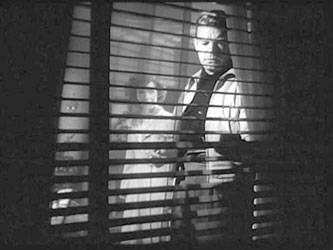
FROM 2007 SAN FRANCISCO, Jan. 28 — The orange and blue neon lights of the Castro Theater shone blurrily on the damp asphalt beneath the crisscrossing catenary wires of the streetcars. The words on the marquee in the Friday night gloom, read:
“Marsha Hunt: In Person.”
Jim Wilson/The New York Times
The Castro Theater in San Francisco on opening night of the Noir City film festival.
Film Noir Foundation
John Ireland and Marsha Hunt in “Raw Deal” (1948).
Jim Wilson/The New York TimesMs. Hunt made more than 50 movies before her career was wrecked in 1950 by the Hollywood blacklist. One of them, a 1948 crime melodrama called “Raw Deal,” has gone on to an unlikely second life as a favorite of the cultish devotees of film noir. On Friday it opened the fifth annual Noir City film festival here, and Ms. Hunt, 89, was on hand to watch its dreamlike silvery hues make a rare appearance on a big — very big — screen.
Lithe and glowing, Ms. Hunt took the stage after the film and said she was surprised not only that this dark little B movie had found fans nearly 60 years after its release, but that so many of them were here, nearly filling the Castro’s more than 1,400 seats. The crowd was a mix of young and old, polished and scruffy, with only a few fedoras in sight.
“I can’t get over this,” Ms. Hunt said as the film festival’s founder and organizer, Eddie Muller, genially interviewed her at the foot of the stage. “It was a strange sort of film,” she added, “about as negative as you can get. They hadn’t coined the term ‘noir’ yet.”
She’s right. It’s hard to imagine a darker film, literally or figuratively, than “Raw Deal.” Consisting almost entirely of luminescent day-for-night photography, it’s the story of an escaped con (played by Dennis O’Keefe) and the two women who love him (Ms. Hunt was one; Claire Trevor was the other), and features, among other pitch-black set pieces, a villain (Raymond Burr) who disfigures his girlfriend with a flaming dessert, and a furious midnight brawl in a seaside taxidermy shop. At the end everyone is either ruined, dead or under arrest.
And that darkness was just fine with the moviegoers here, which applauded vigorously as the closing titles rolled, just as they had at the beginning when the credit for the film’s director of photography, John Alton, the master of all that darkness, appeared on screen.
Ed here: interesting to note that John Ireland gets top billing when the stars are Dennis O'Keefe and Marsha Hunt. But then nobody would know who O'Keefe is, right? Fair enough.
But if you grew up in Iowa you knew O'Keefe, of course. he was born here. He had a decent career in the Bs as a sort of road show Cary Grant. Most of his films were forgettable but every once in a while he stumbled over a good script. This is his best movie and one hell of a good noir. Three times a decade the film magazine carry articles claiming that O'Keefe's career needs to be reconsidered. I don't know about that but here, older, heavier, a real sadness in the gaze, he does some fine fine work. And Raymond Burr is truly scary.

No comments:
Post a Comment